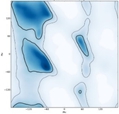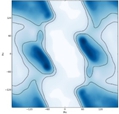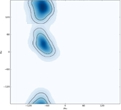So now that we know the basics of a Ramachandran plot, we're going to talk about atypical Ramachandran plots. It turns out that there are 2 amino acids with atypical Ramachandran plots, and those are glycine and proline. By atypical, we really mean that they have very unique Ramachandran plots. The other 18 amino acids all have Ramachandran plots that are very similar and look like the ones that we saw in our previous lesson. However, glycine and proline have really unique Ramachandran plots that stand out from all the other 18. We'll first talk about glycine's Ramachandran plot and then we'll discuss proline's Ramachandran plot in a different video.
Glycine's Ramachandran plot is atypical because glycine has a very small R group. In fact, it's the smallest R group of them all, and its R group is so small that it does not significantly limit the phi and psi bond rotations encountered by glycine's R group. Recall that glycine's three-letter code is GLY, and its one-letter code is G. Again, glycine's R group is the smallest, which allows for significantly more flexibility. Recall from our previous lesson that the white regions in a Ramachandran plot represent non-permissible angles, and they're non-permissible due to steric hindrance. In our previous Ramachandran plot, if you remember, the right side of the Ramachandran plot was predominantly non-permissible, mostly white except for tiny regions. But with glycine's Ramachandran plot, notice that it has permissible bond angles in pretty much every single quadrant: the left quadrant, upper left, bottom left, upper right, and bottom right. Glycine's Ramachandran plot can take on permissible bond angles in virtually every single quadrant, which is very unique.
Glycine is the only amino acid that has this ability due to its very small R group that encounters very little steric hindrance. This is a key feature of glycine, and we will be able to refer back to this in some of our different topics later throughout our course. It's important to keep in mind that glycine's R group gives it this special feature of adapting different bond angles that other amino acids can't take on, and it can fit into small spaces that other amino acids can't fit into.
This concludes our lesson on the atypical Ramachandran plot of glycine. We'll get some practice, and then we'll talk about the atypical Ramachandran plot of proline. I'll see you guys in those videos.




